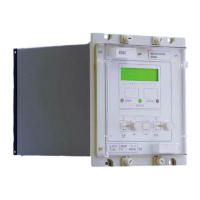Manual
KVCG202/EN M/H
then decrementing or incrementing the address. Then exit setting mode as described in
Chapter 3.4.3.
There is a feature in Courier that can be used to automatically allocate an address to the
relay, provided the master station software supports this feature. It is recommended that
the user enters a name for the plant reference in the appropriate menu cell and then sets
the address manually to “0”. If auto addressing has been selected in the master station
software, the master station will then detect that a new relay has been added to the
network and automatically allocate the next available address on the bus to which that
relay is connected and communications will then be fully established.
3.4.13 Setting input masks
An eight bit mask is allocated to each control function that can be influenced by an
external input applied to one or more of the logic inputs. When the menu cell for an input
mask is selected the top line of the display shows text describing the function to be
controlled by the inputs selected in the mask. A series of “1”s and “0”s on the bottom line
of the display indicate which logic inputs are selected to exert control. The numbers
printed on the front plate under the display indicate each of the logic inputs (L7 to L0)
being displayed. A “1” indicates that a particular input is assigned to the displayed control
function and a “0” indicates that it is not. The same input may be used to control more
than one function.
3.4.14 Setting output masks
An eight bit mask is allocated to each control function. When a mask is selected the text
on the top line of the display indicates the associated function and the bottom line of the
display shows a series of “1”s and “0”s for the selected mask. The numbers printed on
the front plate under the display indicate the output relay (RLY7 to RLY0) that each bit is
associated. A “1” indicates that the relay will respond to the displayed function and a “0”
indicates that it will not.
A logical “OR” function is performed on the relay masks so that more than one relay may
be allocated to more than one function. An output mask may be set to operate the same
relay as another mask so that, for example, one output relay may be arranged to operate
for all the functions required to block tap operations and another for only those functions
that are to initiate tap change.
3.4.15 Resetting values
The values of highest tap, lowest tap, total number of operations and total number of
frequent operations can be reset to zero. To achieve the menu cell containing the values
to be reset (measure column) must be displayed and then the [0] key held depressed for
at least one second to effect the reset.
3.4.16 Resetting CONTROL LED indication
If the tap change operation is blocked the “CONTROL’ LED is lit permanently and the
textual information for the condition is displayed via the correct default display. If any of
the following conditions are detected, the ‘CONTROL’ LED will flash and the textual
information for the condition is displayed via the correct default display:
- Tap change failure [Tfail]
- Number of tap change operations[TotalOps]
- Frequent tap change operations [FreqOps]
- Run Away Protection [RunAway]
The ‘CONTROL’ LED can be reset only after these conditions are cleared by depressing
the [0] key for 1 second.
The only other time the ‘CONTROL’ LED is lit permanently is when the inter-tap delay is
set to zero for continuous tap change operation.
3.5 External connections
Standard connection table

